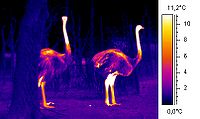
Photo from wikipedia
Resolving the combined effect of climate warming and exploitation in a food web context is key for predicting future biomass production, size-structure, and potential yields of marine fishes. Previous studies… Click to show full abstract
Resolving the combined effect of climate warming and exploitation in a food web context is key for predicting future biomass production, size-structure, and potential yields of marine fishes. Previous studies based on mechanistic size-based food web models have found that bottom-up processes are important drivers of size-structure and fisheries yield in changing climates. However, we know less about the joint effects of ‘bottom-up’ and physiological effects of temperature; how do temperature effects propagate from individual-level physiology through food webs and alter the size-structure of exploited species in a community? Here we assess how a species-resolved size-based food web is affected by warming through both these pathways, and by exploitation. We parameterize a dynamic size spectrum food web model inspired by the offshore Baltic Sea food web, and investigate how individual growth rates, size-structure, relative abundances of species and yields are affected by warming. The magnitude of warming is based on projections by the regional coupled model system RCA4-NEMO and the RCP 8.5 emission scenario, and we evaluate different scenarios of temperature dependence on fish physiology and resource productivity. When accounting for temperature-effects on physiology in addition to on basal productivity, projected size-at-age in 2050 increases on average for all fish species, mainly for young fish, compared to scenarios without warming. In contrast, size-at-age decreases when temperature affects resource dynamics only, and the decline is largest for young fish. Faster growth rates due to warming, however, do not always translate to larger yields, as lower resource carrying capacities with increasing temperature tend to result in declines in the abundance of larger fish and hence spawning stock biomass. These results suggest that to understand how global warming affects the size structure of fish communities, both direct metabolic effects and indirect effects of temperature via basal resources must be accounted for.
Journal Title: Global Change Biology
Year Published: 2022
Link to full text (if available)
Share on Social Media: Sign Up to like & get
recommendations!